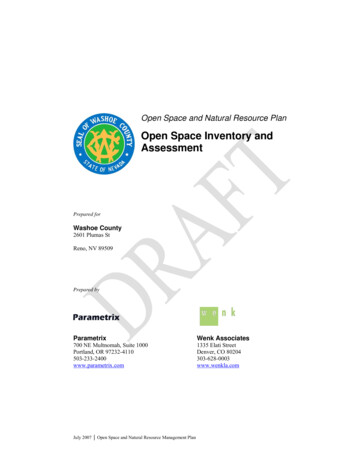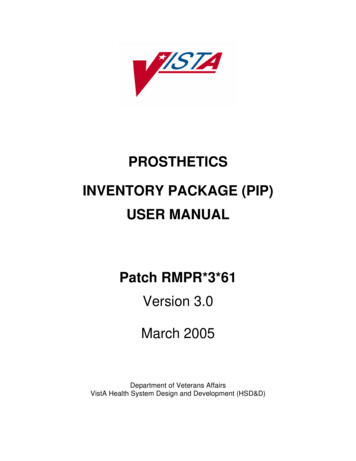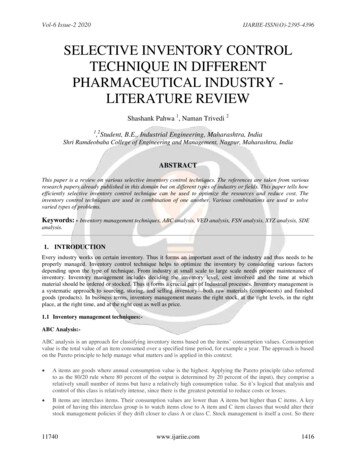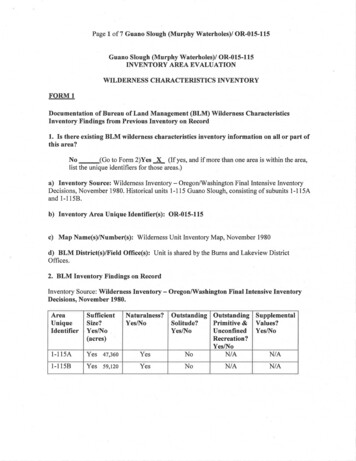
Transcription
Open Space and Natural Resource PlanOpen Space Inventory andAssessmentPrepared forWashoe County2601 Plumas StReno, NV 89509Prepared byParametrixWenk Associates700 NE Multnomah, Suite 1000Portland, OR 97232-4110503-233-2400www.parametrix.com1335 Elati StreetDenver, CO 80204303-628-0003www.wenkla.comJuly 2007 Open Space and Natural Resource Management Plan
CITATIONWashoe County. 2007. Open Space Inventory andAssessment. Prepared by Parametrix and WenkAssociates, Portland, Oregon. July 2007.
Open Space Inventory and AssessmentWashoe CountyTABLE OF CONTENTS1. INTRODUCTION AND BACKGROUND.1-11.1 BACKGROUND FOR THE PLANNING EFFORT.1-11.2 INTRODUCTION: PURPOSE AND ROLE OF THE REPORT.1-12. RESOURCE SCAN .2-33. INVENTORY AND MAPPING .3-53.1 UNIQUE GEOLOGIC FEATURES.3-53.1.1 Scenic Areas .3-53.1.2 Areas of Steep Slopes.3-63.2 AREAS OF CRITICAL ENVIRONMENTAL CONCERN .3-63.3 CULTURAL RESOURCE AREAS .3-73.4 UNIQUE WATER RESOURCES .3-83.4.1 The Truckee River Corridor .3-83.4.2 Steamboat Creek.3-93.4.3 Major Ditch Corridors .3-93.4.4 North Valley Playa .3-93.4.5 Washoe Lake .3-103.4.6 Pyramid Lake .3-103.4.7 Lake Tahoe .3-113.4.8 Wetlands.3-113.4.9 Floodplain Zones.3-113.4.10 Geothermal Areas.3-123.5 RECREATIONAL OPPORTUNITIES AND CONNECTIVITY.3-123.5.1 Public Lands .3-123.5.2 Tribal Lands .3-134. ASSESSMENT.4-144.1 UNIQUE GEOLOGIC FEATURES.4-144.1.1 Scenic Areas .4-144.1.2 Areas of Steep Slopes.4-144.2 AREAS OF CRITICAL ENVIRONMENTAL CONCERN .4-154.3 CULTURAL RESOURCE AREAS .4-154.4 UNIQUE WATER RESOURCES .4-154.4.1 The Truckee River.4-154.4.2 Steamboat Creek.4-164.4.3 North Valleys Playa.4-174.4.4 Wetlands.4-174.4.5 Floodplain Zones.4-17July 2007 Open Space and Natural Resource Management Plani
Open Space Inventory and AssessmentWashoe CountyTABLE OF CONTENTS (CONTINUED)4.5 RECREATIONAL OPPORTUNITIES AND CONNECTIVITY.4-17iiJuly 2007 Open Space and Natural Resource Management Plan
ACRONYMSACECArea of Critical Environmental ConcernBLMBureau of Land ManagementGISGeographic Information SystemNDOWNevada Department of WildlifeNWINational Wetland InventoryOHVOff Highway VehiclePMUSage Grouse Population Management UnitROSPReno Open Space PlanSRTScience Review TeamSWReGAPSouthwest Regional Gap Analysis ProjectUSFSUnited States Forest ServiceWAPTWildlife Action Plan TeamJuly 2007 Open Space and Natural Resource Management Planiii
1.INTRODUCTION AND BACKGROUND1.1 BACKGROUND FOR THE PLANNING EFFORTOpen spaces and natural resources are an integral part of life in Washoe County. From theearly history of the region and the promise of a new life in the West, to the captivating beautyof the canyons and mountains, Washoe County has been defined by what the natural worldhas provided here. For this reason, the Southern Washoe County Regional Open Space andNatural Resource Management planning effort was initiated at the beginning of 2007 toassess and plan for how to manage these resources. It is at once an effort to update the 1994Washoe County Regional Open Space Plan and create a new Natural Resource ManagementPlan for the southern portion of Washoe County. The study area addressed in this reportincludes all of Washoe County south of the northern shores of Pyramid Lake (See Figure 1)and south to Carson City. This planning effort represents phase one of a long-term effort tocreate open space and natural resource management plans for the entire county.The study area includes the county’s urban areas, private lands, public lands, and in someareas a mix of public and private ownership. The region includes extensive tribal lands aswell. The multiple ownerships and uses have resulted in an increase in competition forresource and open space use. From expanding urban centers and communities, to increasedwater consumption, and outdoor activities, the region’s open space and natural resources areexperiencing more pressure and use than in the past. This plan strives to both create a way tobest share the experiences and values from the landscape, and conserve them for future use.For everyone in the county, the wide open spaces, striking natural skylines, rich natural andcultural history, and unique ecosystems all make Washoe County a special place for thosewho call it home.Preserving this natural value is not without challenges and choices. This plan is not meant toserve as a static inventory of resources and tools– it is a plan for action to maintain, conserveand restore the open spaces and natural resources of the region. To do so the project teamassessed the existing state of open space and natural resources, and developed a future visionand set of principles to guide current and future efforts to plan for and manage theseresources. Using an extensive technical and public involvement process, development andanalysis of scenarios for achieving this vision led to choices about how to manage theseresources. Finally, an implementation strategy was prepared with the County and its planningpartners within the region to provide the necessary support and tools to ensure the planachieves its stated vision over time.1.2 INTRODUCTION: PURPOSE AND ROLE OF THE REPORTThree inventory and assessment reports were prepared for the plan. Natural Resources Open Space Parks and RecreationThe reports are based on the best available science and studies at this time. No new data wascollected, but local resource managers, academic researchers, and local stakeholders and usergroups were consulted to bring the best information to the plan. The three reports are craftedto be stand-alone documents that support decision-making and planning on the topics theycovered. These reports provide the framework for the plan and by including the detailedJuly 2007 Open Space and Natural Resource Management Plan1-1
assessments here the plan itself is more reader friendly. Because these three reports are meantto be read independently, there is some overlap between them. Open space, natural resources,and park and recreation all share some components that are addressed in each, though oftenthrough different perspectives.These reports are intended to help the project team develop scenarios for testing local valuesabout resources and assess management options. These scenarios in turn, will form the basisfor physical and policy recommendations and the final implementation strategy.It is the project team’s intent that these reports will serve future planning and decisionmaking efforts in the county by serving as a starting point for how to assess resources andissues in the region in other planning efforts. Finally, the reports serve as a platform forrevisiting the Open Space and Natural Resource Plan as it is reevaluated and updatedperiodically in the future.1-2July 2007 Open Space and Natural Resource Management Plan
2.RESOURCE SCANOpen space for this project is defined as “Undeveloped land with significant natural, culturaland visual resources that is integral to Washoe County’s quality of life.” To this end, areaswith significant cultural, scenic, and recreational values are assessed and evaluated withinthis document to help guide resource protection and stewardship decisions. The resourcevalues considered here include: unique geologic features areas of critical environmental concern unique water resources cultural resources recreational opportunities community shaping open space urban open spaceThreatened or endangered species and areas of significant habitat are considered in acompanion inventory and assessment report.Washoe County’s GIS data is the source for all mapping presented in this report incooperation with Federal, State and local partners. Coverage and adequacy of the data aresummarized belowUnique geologic features: Map data include topographic relief, which allows for theidentification of major mountain ranges, ridgelines and valleys, and for the identification ofsignificant peaks. Additional scenic areas that may be important to the planning effort areexpected to be identified by the Science Review Team involved in the planning process. Thisdata also allows for identification of areas with steep slopes.Areas of Critical Environmental Concern: The Areas of Critical Environmental Concern(ACEC) program is managed by the Bureau of Land Management. The ACEC program wasconceived in the 1976 Federal Lands Policy and Management Act which established the firstconservation mandate for the BLM. The ACEC mandate directs the BLM to protectimportant riparian corridors, threatened and endangered species habitat, cultural andarcheological resources and unique scenic landscapes throughout the Southwest that theagency believes need special management attention. GIS data provided by the Countyidentify locations of five Areas of Critical Environmental Concern.Unique Water Resources: Map data include the Truckee River and tributary streams anddrainage-ways, lakes, wetlands, extents of the 100-year and 500-year floodplain, andlocations of known geothermal resources and wells. Wetland data appear to have beenderived from the National Wetland Inventory data set, but the date is unknown.Cultural resources: Map data include general locations for significant concentrations ofarchaeological and historic resources. The polygons represented on the maps should not beinterpreted as exact areal extents of resource locations, but rather more general locationswhere significant concentrations of resources have been found. Much of the project area hasnot been formally surveyed, so it is likely that additional concentrations of resources may befound at other locations. Additional locations for cultural resources and uses are known toJuly 2007 Open Space and Natural Resource Management Plan2-3
tribal representatives and archaeologists who have been studying these sites. Formalconsultation with these representatives will be necessary to identify additional site locationsso these areas may be protected, without necessarily mapping these areas and revealing theirlocations.Recreational opportunities: Map data allow for the identification of Federal, State, andlocal open space, wilderness areas, parks, and trail connections. The data also identifyadditional privately-held lands that, if conserved in some manner, would provide importantconnections between open space or park areas.Other source documents examined include:2-4 Washoe County Comprehensive Plan, Conservation Element (draft update, 2006) Washoe County Comprehensive Plan, Area Plans and Specific Plans (various dates) Washoe County Regional Open Space Plan (1994) Natural Resources Portion of Truckee Meadows Regional Plan (2006) 2004 – 2025 Washoe County Comprehensive Regional Water Management Plan(2005) Nevada Natural Resources Status Report (2002) “Living River” Plan, Truckee River Flood Management Project (2006) Steamboat Creek Restoration Plan (PowerPoint presentation summary, 2006) Reno Open Space and Greenways Plan (2007)July 2007 Open Space and Natural Resource Management Plan
3.INVENTORY AND MAPPINGThis inventory section describes the location and extents of each of the resources listedabove. As the pace of development continues, the supply of land with suitable or desirablefeatures continues to diminish. Preservation of lands with significant scenic, hydrologic,cultural, and recreational qualities and features is necessary to maintain the County’s qualityof life.3.1 UNIQUE GEOLOGIC FEATURESTopographic and scenic areas can include visually significant mountain ranges, ridgelines, orindividual mountain peaks, as well as the valley floor. They form a significant backdrop andcontrast to the more urbanized portions of the County and are a part of the day-to-day “visualexperience” for both residents and visitors. If these areas were to fully develop, the quality ofthis experience would change dramatically.3.1.1 Scenic AreasFigure 2 illustrates major scenic areas identified through County GIS data, as well assuggested by the general public during an initial planning workshop. Major scenic areas,working clockwise around the map beginning at the southwest edge of the planning area,include: The Mt. Rose Wilderness Area, which encompasses over 28,000 acres and includes14 distinctive mountain peaks within the Carson Range. This area is a distinctive“landmark landscape” southwest of Reno and its scenic quality was cited by thegeneral public. Peavine Mountain, north and west of Reno, and which includes both Peavine Peak aswell as nearby South Mountain. The southern face of Peavine Peak is in privateownership and the public has raised concerns about impacts to this resource if thisarea is allowed to develop further. The Peterson Mountains, which span the border between Nevada and California,north and west of Reno, and which include the Peterson Mountains Natural Area. Pyramid Lake, which encompasses 188 square miles and which is one of the largestlakes in the United States. The lake is the largest remnant of ancient Lake Lahontanthat covered much of northwestern Nevada at the end of the last ice age. The Dogskin Mountains, which are visible to the west from the Pyramid Highwayand which also have cultural significance. The Virginia Mountains, which are visible along the western edge of Pyramid Lake. Hungry Valley, which parallels the Pyramid Highway and which also has culturalsignificance. The Pah Rah Range, to the south of Pyramid Lake. The Truckee River, which flows from west to east and provides a visual experience of“nature in the City,” especially in its easternmost reach through the City of Sparks. The Virginia Range, which lies on the southeast side of Truckee Meadows and whichform the southeast boundary of our planning area. These foothills, sparsely vegetatedin sagebrush and pinon pine/juniper communities, form a very significant backdropand edge to the County. Also on the east side is the Huffaker Hills, includingJuly 2007 Open Space and Natural Resource Management Plan3-5
privately-owned Rattlesnake Mountain, a very significant and recognizable featurewithin the foothills. Steamboat Creek and the “Steamboat Bottoms.” This area is a unique interfacebetween the valley floor and the foothills. The original marsh or bog is the low pointin the Truckee Meadows, and was one of the first sights to greet wagon trains as theywound their way up the Truckee River. The Overland Emigrant Trail, whichfollowed the base of the Virginia Range, then along the Huffaker Hills to southwestTruckee Meadows, is still visible in this area in selected locations. Washoe Lake and Washoe Valley, on the southern edge of the project area. Lake Tahoe, at the far southwestern edge of the project area.3.1.2 Areas of Steep SlopesIn addition to significant physiographic features, the locations of steep slopes (slopes greaterthan 15 percent, and slopes greater than 30 percent) were also mapped. Because slopesgreater than 15 percent can be challenging development sites, due to erosion potential as wellas visual impacts associated with building on ridgelines or foothill flanks, these locationswere identified as possible future candidates for preservation. Within Washoe County, slopesgreater than 30 percent are deemed unsuitable for development.Figure 2 also illustrates this analysis. As suggested by the mapping, foothills on the easternand southern flanks of the Pah Rah Range, and smaller extents of foothills within LemmonValley, Hungry Valley, constitute slopes within the 15 to 30 percent category; to the extentthat these lands are held privately, they may at some point be slated for development.3.2 AREAS OF CRITICAL ENVIRONMENTAL CONCERNFigure 3 shows the approximate locations of five Areas of Critical Environmental Concernthat have been identified within the planning area. These include: An area of Incandescent Rocks, which are for the most part rhyolitic or dacitic rockscalled flowdomes that are volcanic in origin. An approximately 243-acre habitat zone for the Carson Wandering Skipper, one offour Federally-listed species in the project area. The 3,881-acre Pah Rah High Basin (Dry Lakes) Petroglyph District, located east ofSparks and containing significant archaeological resources. The Steamboat Buckwheat, which occurs only on the geothermally-derived “sinter”soils at Steamboat Hot Springs and which was Federally-listed in 1986, when facedwith increasing threats to its habitat from development. The 40-acre ACEC alsoprotects the geothermal resources that underlie the area. A Memorandum ofUnderstanding (MOU) for recreational development (interpretation, picnic areas, andpedestrian traffic) of the Steamboat ACEC exists between the BLM Carson CityDistrict and Washoe County Parks and Recreation Department (BLM 1983). The 473-acre Virginia Range Williams Combleaf Habitat Area ACEC. WilliamsCombleaf is listed as critically endangered by the State of Nevada.The map shows general locations where these species have been sighted. Polygonsshould not be interpreted as depicting the entire areal extent of these species.3-6July 2007 Open Space and Natural Resource Management Plan
3.3 CULTURAL RESOURCE AREASThere are presently over 5,000 known cultural sites in southern Washoe County. Most ofthese sites have not been formally surveyed or studied, so the map shown in Figure 4illustrates where there are major concentrations of archaeological and historic resources.Because of concerns about possible resource degradation, the map also shows general areasand not specific locations.Areas with significant concentrations of resources include: Warm Springs Valley. Archaeologists have identified numerous archaeological sites,all relating to the Archaic period occupation of the area, and including lithic debris,groundstone and hearths. Hungry Valley. Lithic scatters are evidence of the prehistoric occupation of this area. Spanish Springs Valley, along the Pyramid Highway. This area includes botharchaeological and historic sites. At one time the area included a marsh, and the sitesprovide evidence of use of marsh resources. Spanish Springs Canyon. The canyon and surrounding area constitute the site of twodry lake beds surrounded by basalt outcroppings. The outcroppings are covered inpetroglyphs and contain rock circles and hunting blinds. Peavine Mountain. This is the site of historic Poeville, where some 1,500 peoplelived during the mid-1860s, mining gold and silver. Many artifacts reflect thismining activity. Basque sheepherders left carvings on the aspens, marking theirpassage through the area. Archaeological sites occur in the canyons. Truckee River Corridor. This corridor includes both archaeological and historicresources. Fishing camps, residential base camps and rock art are found along thelength of the river. As the area was gradually settled beginning in the 1840s andcontinuing through the 1870s, the river became the locus of commercial activity,farming and ranching. Steamboat Creek. This corridor also includes evidence of prehistoric settlement,including archaeological artifacts, rock art, seasonal camps, and permanentresidential sites. Occupation seems to have been heaviest during late Archaic times.South of the Mt. Rose Highway junction, sites along the creek are larger and reflectmore intensive use, probably as winter camps. This was likely due to the perennialwater source, the bog and wetland area which provided materials for baskets, and theplentiful supply of game. Huffaker Hills. Lithic scatters with groundstone, game fences and hunting blinds areevidence of prehistoric settlement. A historic ranch is also located in this area. Double Diamond Ranch. This area includes over 20 archaeological sites, with lithicscatters, groundstone, and hearths. Steamboat Quarries. These were created by people exploiting naturally-occurringbasalt and sinter debris, to fashion into tools. Galena Town Site. This was principally a lumber camp established in 1860 tosupport the Comstock Mines. Silver ore was also found in this area. Eleven sawmillswere in operation by 1863, but by 1867 the town had been destroyed by fire.July 2007 Open Space and Natural Resource Management Plan3-7
Washoe Lake. The entire lake is considered an archaeological district. The dunes onthe eastern shore contain lithic scatter, bones, hearths, burial areas, and a Clovispoint. In more modern times, Washoe City was founded on the northern shore, andseveral thousand people inhabited the City in the mid-1860s. When the Comstocksawmills closed, and population began to decline to fewer than 200. A few residencesremain along with remnants of old foundations. Jumbo Town Site and Mining District. This area was developed between 1908-10,during the early 20th century mining boom, but produced very little. A few woodstructures and mining elements remain. Hobart Reservoir, Franktown Creek, and Little Valley. In 1853, Mormon farmersfounded Franktown. In the early 1860s, the demand for lumber in the nearby minesresulted in establishment of sawmills. Hobart Reservoir is part of the Marlette WaterSystem constructed in 1873 to carry water to Virginia City. Many of the residences,and the Marlette Water System, are eligible for the National Register.Figure 4 also shows grid locations where some survey mapping has been completed, andsome resources have been found, according to GIS data supplied by Nevada’s State HistoricPreservation Office (SHPO). These should be taken as general indicators of where resourceshave been discovered, but the data do not indicate exactly where resources have been foundwithin the grid, nor the quantity and significance of the discovery. Readers will also note thatmany areas remain unmapped, so the potential for future discovery of additional resources inthese areas remains untapped.3.4 UNIQUE WATER RESOURCESFigure 5 shows the locations of major hydrologic and surface water resources found withinthe project area.3.4.1 The Truckee River CorridorThe Truckee River flows approximately 100 miles from its source at Lake Tahoe, throughReno and Sparks to its terminus at Pyramid Lake. It includes many valuable resources,including wetlands, a natural floodway, fish habitat, an important natural and scenic corridorwithin the heart of the cities for Reno and Sparks, and an important source of drinking waterfor the communities that surround it.The Truckee River is the most significant natural resource in the plan area. Native riparianhabitat still exists along much of the river, supporting associated animal species. OxbowNature Study Area, a largely intact segment of river habitat, supports populations of beaverand muskrat, as well as numerous bird species. A number of more developed parks along theriver include both native riparian habitat adjacent to the river, and nearby developed areaswith non-native, ornamental plant species.Fish habitat within the corridor has become degraded due to water diversion and sedimentscarried by urban runoff. In the past, it had provided habitat for at least eight native species offish, which had unimpeded access from Lake Tahoe, all the way along the river to PyramidLake. The original strain of Lahontan cutthroat has now been extirpated and the prehistoriccui-ui, a non-game fish is listed as threatened.Fish presently found within the river include native and non-native species, including browntrout, Lahontan cutthroat trout, rainbow trout, mountain whitefish, large-mouth bass, blackcrappie, and channel catfish. Major threats to habitat are chemical pollution carried by urbanrunoff. Nutrients also enter the river due to runoff from construction sites and from treated3-8July 2007 Open Space and Natural Resource Management Plan
wastewater discharged from the Reno-Sparks Wastewater Treatment facility. Channelstraightening, loss of vegetation along the streambank that might have provided shade, andstream flow regulation have all combined to increase water temperatures that make itchallenging to sustain a cold-water fishery. As a consequence, fish like the brown trout,which are more resistant to high temperature and degraded water quality, have come todominate aquatic species.3.4.2 Steamboat CreekSteamboat Creek has historically been a valuable water resource and provided early settlerswith water for agricultural uses. The creek originates at the outlet of Little Washoe Lake andmeanders for 17.5 miles to the Truckee River. The Steamboat Creek Watershed encompassesapproximately 200 square miles in Washoe CountySteamboat Creek has been used in the Reno area for a variety of reasons over the years thatinclude both agriculture and mining. This use has led to some environmental damage andconcern. Steamboat Creek is the largest non-point source of pollutants discharged into theTruckee River, including naturally occurring arsenic and boron. Some pollutants, likemercury, are a result of historic mining activities. Much of the pollution is derived fromseveral sources including livestock manure, residential and other uses of fertilizers and urbanrunoff from Reno.Steamboat Creek is recognized as a significant resource to the Reno area and as a result arestoration plan was created to repair and control the pollution to this water way. TheSteamboat Creek Restoration Plan emphasis maintaining public access to the creek whileproviding residents an opportunity to learn about this resource and ways they can help toprotect it. The plan also focuses on working with adjacent land owners to prevent damage andreduce pollution. The Steamboat Creek Restoration Plan has been implemented on sections ofthe creek and continues to be implemented with the help of residents and adjacentlandowners.3.4.3 Major Ditch CorridorsFigure 5 also illustrates the locations of an extensive system of irrigation ditches that havesupplied water to agricultural operations within the Truckee Meadows area. While many ofthese ditches are no longer active, they can provide a framework for a recreational trailssystem, and so should be studied further.3.4.4 North Valley PlayaThree playas, White Lake, Silver Lake, and Swan Lake, are located in the North Valleys area.Desert playas are valley bottoms where seasonal water collects in pools during periods ofhigh precipitation or run-off, but which have little or no water during drier portions of theyear. Playas that have a perennial source of water, such as Swan Lake, may shrink in size butnot go completely dry.All three playas provide watershed functions, wildlife and native plant habitat, opportunitiesfor connectivity, and recreational opportunities. The setting, characteristics, and open spaceopportunities for each playa are described below. White Lake. White Lake is bordered by residential development on the north withsporadic commercial and light industrial development to the east and south. The lakeis owned by a limited number of private landowners. The undeveloped landsurrounding White Lake is a mixture of seasonal wetland and sage scrub. White LakeJuly 2007 Open Space and Natural Resource Management Plan3-9
provides significant groundwater recharge and watershed protection value, offersvisual relief, and
July 2007 Open Space and Natural Resource Management Plan Open Space and Natural Resource Plan Open Space Inventory and Assessment Prepared for Washoe County 2601 Plumas St Reno, NV 89509 Prepared by Parametrix 700 NE Multnomah, Suite 1000 Portland, OR 97232-4110 503-233-2400 www.parametrix.com Wenk Associates 1335 Elati Street










